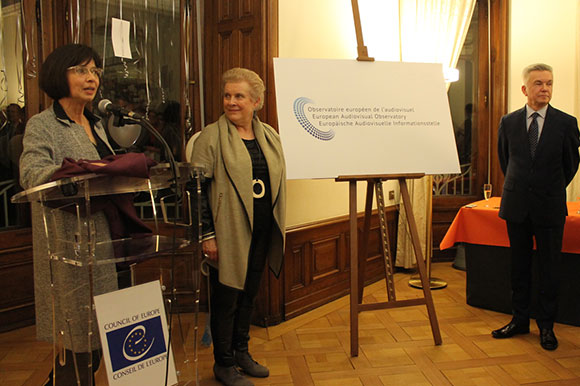 The new logo was unveiled yesterday evening at the Observatory's New Year's Reception by Catherine Trautmann representing the City of Strasbourg and newly elected President of Eurimages, and Polish Ambassador to the Council of Europe, Janusz Stańczyk.
The new logo was unveiled yesterday evening at the Observatory's New Year's Reception by Catherine Trautmann representing the City of Strasbourg and newly elected President of Eurimages, and Polish Ambassador to the Council of Europe, Janusz Stańczyk.
Susanne Nikoltchev, the Observatory’s Executive Director, looked forward to « an exceptionally dynamic and fruitful 25th anniversary » for the new-look Observatory. The ambitious programme for 2017 includes a public conference on “Key trends from the audiovisual market and regulation” on the 16th of March in Strasbourg, the Observatory’s traditional must-attend Cannes workshop during the first week end of the Cannes Film Market and the Observatory’s now well established Brussels conference in autumn of this year. New reports on subjects as diverse as the panorama of TV and on‐demand services in Europe, media ownership, the future of advertising or indeed copyright will be published by the Observatory in the course of the year. Nikoltchev saw the 25th anniversary of the Observatory as a chance to boost the Observatory’s role as « the absolute reference for market and legal analysis of the audiovisual industries in Europe ». She particularly looked forward to working with the 2017 Polish Presidency, a founding member of the Observatory and « staunch supporter » of its work. She paid tribute to the 2016 Czech Presidency and thanked Lenka Holubová Mikolášová (left) of the Czech Ministry of Culture for her “unflagging energy” during 2016.
The Observatory’s Polish Presidency for 2017 will be represented by the Polish National Broadcasting Council – the KRRiT. Halina Rostek (right), Deputy Director of the Department of Strategy in the KRRiT’s Office will head up the Observatory’s Polish Presidency for 2017. A public conference on media literacy in Warsaw is already announced for the 8th of June as part of the Polish Presidency’s activities. The European Audiovisual Observatory was created in 1992 in order to reply to a growing political and industrial demand for reliable intelligence on the film and television industries in Europe. 25 years on, it boasts 40 member states and the information it produces (available in the form of reports, databases, on-line services and conferences), covers the fields of cinema, television, on-demand services and media legislation in its 40 member states.



















